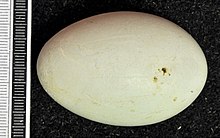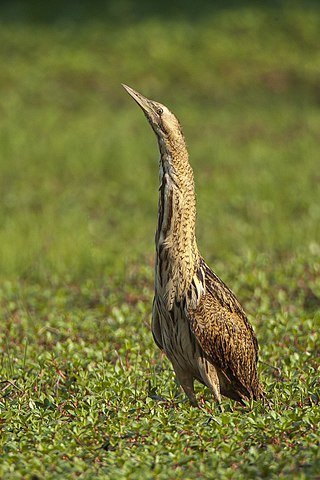
The Eurasian bittern or great bittern is a wading bird in the bittern subfamily (Botaurinae) of the heron family Ardeidae. There are two subspecies, the northern race breeding in parts of Europe and across the Palearctic, as well as on the northern coast of Africa, while the southern race is endemic to parts of southern Africa. It is a secretive bird, seldom seen in the open as it prefers to skulk in reed beds and thick vegetation near water bodies. Its presence is apparent in the spring, when the booming call of the male during the breeding season can be heard. It feeds on fish, small mammals, fledgling birds, amphibians, crustaceans and insects.

Herons are long-legged, long-necked, freshwater and coastal birds in the family Ardeidae, with 72 recognised species, some of which are referred to as egrets or bitterns rather than herons. Members of the genera Botaurus and Ixobrychus are referred to as bitterns, and, together with the zigzag heron, or zigzag bittern, in the monotypic genus Zebrilus, form a monophyletic group within the Ardeidae. Egrets do not form a biologically distinct group from herons, and tend to be named differently because they are mainly white or have decorative plumes in breeding plumage. Herons, by evolutionary adaptation, have long beaks.

The grey heron is a long-legged wading bird of the heron family, Ardeidae, native throughout temperate Europe and Asia, and also parts of Africa. It is resident in much of its range, but some populations from the more northern parts migrate southwards in autumn. A bird of wetland areas, it can be seen around lakes, rivers, ponds, marshes and on the sea coast. It feeds mostly on aquatic creatures which it catches after standing stationary beside or in the water, or stalking its prey through the shallows.

The great egret (Ardea alba), also known as the common egret, large egret, or great white egret or great white heron is a large, widely distributed egret. The four subspecies are found in Asia, Africa, the Americas, and southern Europe. Recently it is also spreading to more northern areas of Europe. Distributed across most of the tropical and warmer temperate regions of the world, it builds tree nests in colonies close to water.

The little egret is a species of small heron in the family Ardeidae. It is a white bird with a slender black beak, long black legs and, in the western race, yellow feet. As an aquatic bird, it feeds in shallow water and on land, consuming a variety of small creatures. It breeds colonially, often with other species of water birds, making a platform nest of sticks in a tree, bush or reed bed. A clutch of three to five bluish-green eggs is laid and incubated by both parents for about three weeks. The young fledge at about six weeks of age.

The slender-billed gull is a mid-sized gull which breeds very locally around the Mediterranean and the north of the western Indian Ocean on islands and coastal lagoons. Most of the population is somewhat migratory, wintering further south to as far as North Africa and India. A few birds have wandered to western Europe. A vagrant individual was reportedly seen on Antigua, April 24, 1976.
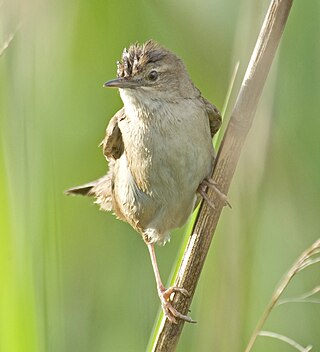
Savi's warbler is a species of Old World warbler in the grass warbler genus Locustella. It breeds in Europe and the western Palearctic. It is migratory, wintering in northern and sub-Saharan Africa.
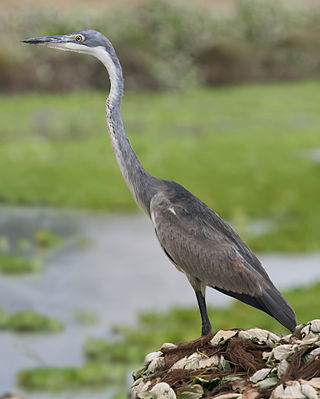
The black-headed heron is a wading bird of the heron family Ardeidae, common throughout much of sub-Saharan Africa and Madagascar. It is mainly resident, but some west African birds move further north in the rainy season.

The white-faced heron also known as the white-fronted heron, and incorrectly as the grey heron, or blue crane, is a common bird throughout most of Australasia, including New Guinea, the islands of Torres Strait, Indonesia, New Zealand, and all but the driest areas of Australia.

The cinnamon bittern or chestnut bittern is a small Old World bittern, breeding in tropical and subtropical Asia from India east to China and Indonesia. It is mainly resident, but some northern birds migrate short distances.
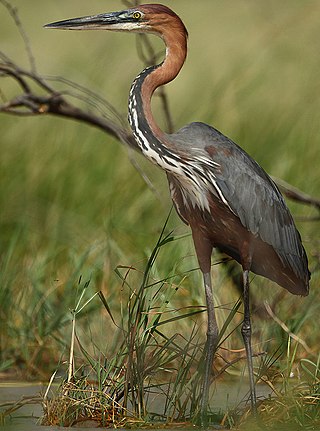
The Goliath heron, also known as the giant heron, is a very large wading bird of the heron family, Ardeidae. It is found in sub-Saharan Africa, with smaller, declining numbers in Southwest and South Asia.
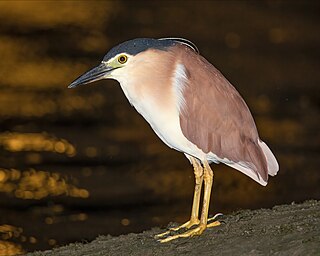
The nankeen night heron is a heron that belongs to the genus Nycticorax and the family Ardeidae. Due to its distinctive reddish-brown colour, it is also commonly referred to as the rufous night heron. It is primarily nocturnal and is observed in a broad range of habitats, including forests, meadows, shores, reefs, marshes, grasslands, and swamps. The species is 55 to 65 cm in length, with rich cinnamon upperparts and white underparts. The nankeen night heron has a stable population size, and is classified as a species of least concern by the International Union for Conservation of Nature (IUCN).

Ardea is a genus of herons. These herons are generally large in size, typically 80–100 cm or more in length.

Humblot's heron, also known as the Madagascar heron, is a species of heron. It is commonly found on the north and west coasts of Madagascar but it is also present in the Comoro Islands and Mayotte. Humblot's heron is considered an endangered species due to its declining population. The major threats the heron faces are poaching, habitat destruction, and the invasion of alien species such as the water hyacinth.

The white-necked heron or Pacific heron is a species of heron that is found on most of the Australian continent wherever freshwater habitats exist. It is also found in parts of Indonesia, New Guinea and New Zealand, but is uncommon in Tasmania. The populations of this species in Australia are known to be nomadic like most water birds in Australia, moving from one water source to another often entering habitats they have not previously occupied, taking advantage of flooding and heavy rain where the surplus of food allows them to breed and raise their young. Population explosions have been known when the environmental conditions are right for this species in places where they have been rare or unknown.

The cocoi heron is a species of long-legged wading bird in the heron family Ardeidae found across South America. It has predominantly pale grey plumage with a darker grey crest. A carnivore, it hunts fish and crustaceans in shallow water.
Bourne's heron, also known as the Cape Verde heron, Cape Verde purple heron or Santiago heron, or locally in Portuguese as the garça vermelha, is an endangered subspecies of the purple heron that is endemic to the Cape Verde archipelago, in the Atlantic Ocean off the coast of West Africa. It is sometimes considered a full species, Ardea bournei.







